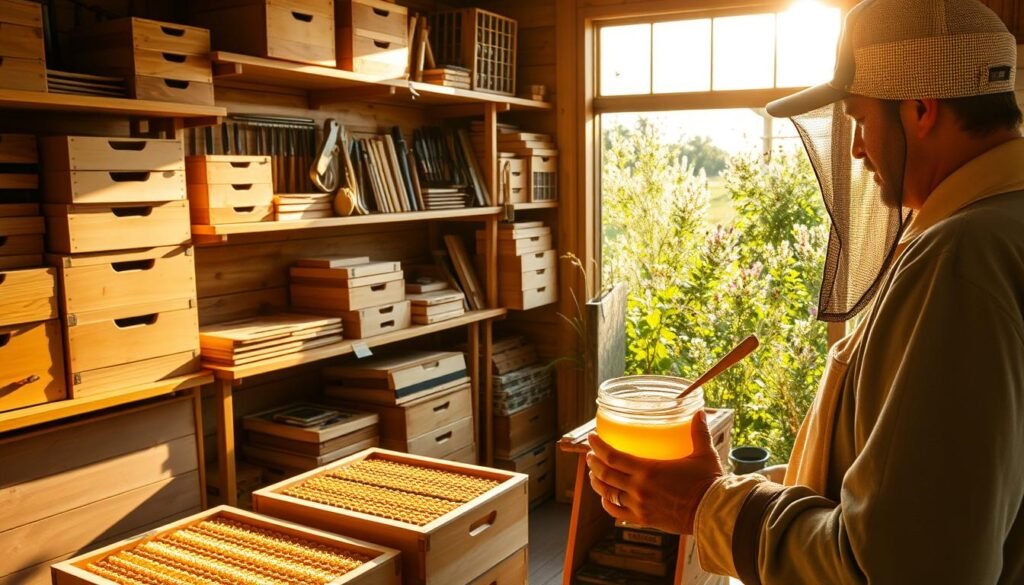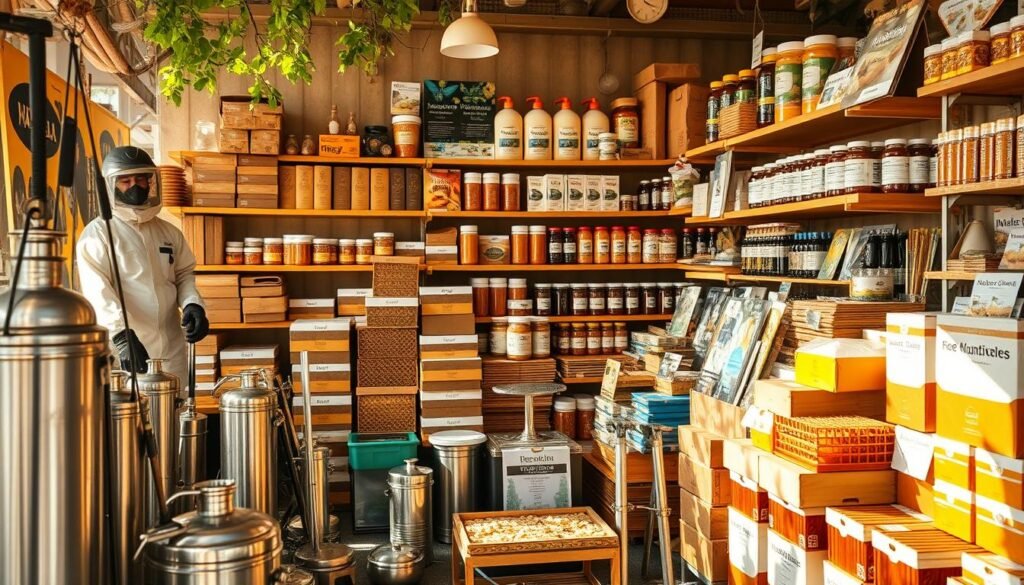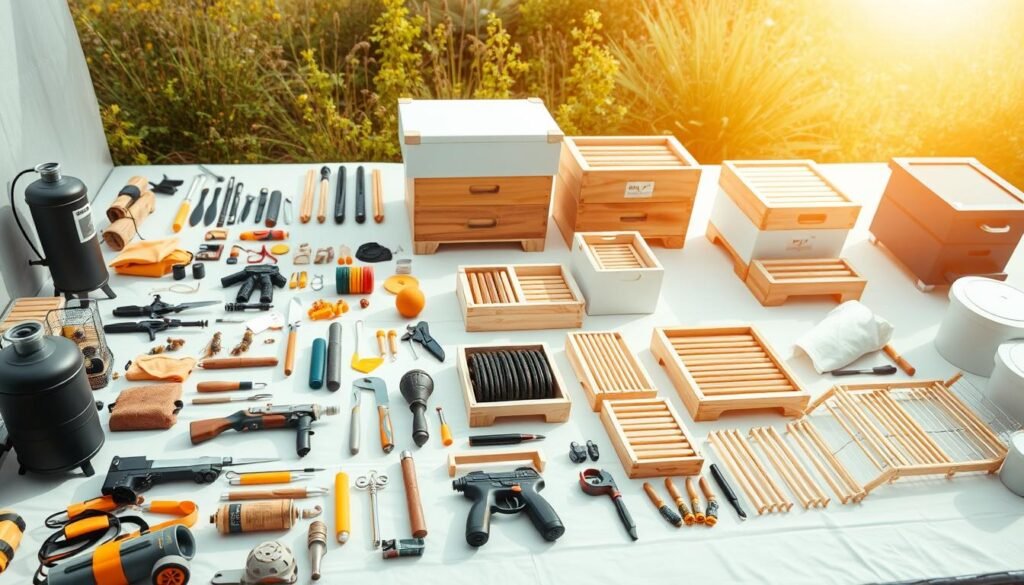Managing healthy honey bee colonies in Australia means tackling threats from all directions. Native critters, invasive species, and tiny parasites create unique challenges for apiarists nationwide. Recognising these risks early helps protect hives and maintain productive pollination systems.
Predators range from large mammals to microscopic pests. Some target adult bees, while others raid hives for larvae or honey. Seasonal changes influence activity patterns, requiring year-round vigilance and adaptable protection methods.
Effective management combines knowledge of local ecosystems with practical deterrent solutions. Identifying tracks, droppings, or hive damage patterns provides clues about specific threats. Proactive measures like secure hive placement and predator-proofing equipment often prevent costly losses.
Key Takeaways
- Native wildlife and invasive species both threaten hive health
- Predator identification guides protection strategies
- Seasonal behaviour affects risk levels
- Combined physical and environmental controls work best
- Early intervention prevents major colony damage
Introduction: Bee Predation in Australian Wildlife
Australia’s buzzing pollinators face constant threats from diverse predators. These interactions shape hive survival rates and influence pollination patterns across ecosystems. Successful management begins with understanding how species coexist and compete.
Overlap in Hunting Strategies
Predatory activity targets pollinators at every life stage. Birds snatch workers mid-flight, while spiders ambush them near flowers. Larger mammals raid hives for protein-rich larvae and energy-dense honey stores.
Seasonal changes alter risk levels dramatically. Winter clusters attract hungry possums, while spring blooms increase exposure to invasive wasps. Beekeepers monitor these patterns to time protective measures effectively.
| Predator Type | Target | Peak Activity | Management Tip |
|---|---|---|---|
| Native birds | Foragers | Daylight hours | Nesting deterrents |
| Introduced wasps | Hive entrance | Summer-autumn | Bait stations |
| Marsupials | Brood comb | Winter nights | Elevated hive stands |
Balancing conservation with apiary protection remains crucial. Selective deterrent methods preserve ecological roles while safeguarding colonies. This approach maintains pollination networks that support Australia’s unique flora.
Understanding what animal eats a bee in Australian Wildlife
Australia’s ecosystems host complex relationships between pollinators and their natural adversaries. These interactions extend beyond simple hunting behaviours, shaping hive resilience and survival tactics.

Defining Feeding Relationships
Direct threats involve hunters like rainbow bee-eaters and dragonflies. These predators actively pursue adult honey bees mid-flight, relying on speed and precision. Their impact peaks during daylight foraging hours.
Indirect risks emerge when brushtail possums tear open hives for larvae. Even if adult bees survive the raid, exposed brood combs often succumb to temperature fluctuations or secondary invaders.
Parasitic organisms operate stealthily. Varroa mites latch onto hosts, draining vital fluids over weeks. Weakened colonies become vulnerable to disease outbreaks and collapsing populations.
Opportunistic feeders include crab spiders ambushing pollinators at flowers. These arachnids don’t specialise in hunting bees but capitalise on their presence near nectar sources. Over 20 insect species exhibit similar casual predation patterns.
Recognising these distinct predation styles allows apiarists to tailor defences. Physical barriers deter mammals, while hive placement reduces spider encounters. Regular mite checks address parasitic threats before colonies collapse.
Native Mammals Impacting Bee Colonies
Australia’s nocturnal marsupials interact with apiaries in unexpected ways. While these creatures rarely destroy hives outright, their curiosity creates unique challenges for colony stability.
Possums and Other Native Marsupials
Brushtail possums often investigate wooden boxes emitting warmth and activity after dark. Their clumsy attempts to access honey stores typically result in agitated bees emerging through the entrance. Opportunistic marsupials then harvest defenders directly from hive fronts.
Sugar gliders present different risks. These small climbers occasionally snatch individual bees but prefer floral nectar. Their light weight prevents significant structural damage to well-built hives.
Three key impacts emerge from marsupial encounters:
- Disrupted thermoregulation in brood chambers
- Increased energy expenditure on defence
- Secondary pest attraction to disturbed colonies
Practical solutions minimise these effects. Elevating hives 50cm above ground deters most climbers. Ratchet straps prevent lid removal attempts while allowing necessary hive inspections.
Night-active species generally avoid persistent attacks when denied easy access. Strategic apiary placement away from tree corridors further reduces unwanted visits from native wildlife.
Invasive Mammalian Predators and Their Effects
Australia’s apiaries face unique challenges from non-native species disrupting delicate ecological balances. These invaders often lack natural population controls, creating outsized impacts on local pollinators through indirect but damaging interactions.

Identifying Introduced Species
European rabbits rank among the most destructive indirect threats. Their burrowing weakens hive stand foundations, creating entry points for snakes and other predators. Apiaries near warrens often report higher brood comb disturbances.
Feral cats exhibit curious behaviours around hives, swiping at low-flying workers. While rarely consuming entire colonies, their presence stresses bees and disrupts foraging patterns. Night-time activity spikes correlate with increased hive defence energy expenditure.
Three key issues emerge with invasive rodents:
- Black rats chew through weaker hive materials
- Nesting invaders block essential ventilation gaps
- Urine contamination alters honey flavour profiles
Wild dogs and foxes pose different risks. Their investigations often topple unstable hive stacks, particularly during dry seasons when water sources attract wildlife. Reinforced stands and motion-activated lights prove effective deterrents.
Successful management combines species-specific strategies with habitat modification. Removing nearby shelter and food sources reduces attraction, while metal hive components thwart persistent chewers. Regular perimeter checks help catch problems early.
The Role of Bears in Apiary Destruction: Lessons for Beekeepers
While Australia lacks native bears, introduced species and escaped individuals demonstrate why these predators rank among nature’s most efficient hive wreckers. Their combination of strength, intelligence, and food-focused determination creates unique challenges for apiary protection.
Understanding Bear Behaviour
Bears possess remarkable spatial memory, recalling productive feeding sites years after initial discovery. A single encounter often leads to repeated raids as they destroy entire apiaries searching for energy-rich honey and protein-packed brood. Their powerful claws shred wooden components effortlessly.
Mitigation Techniques for Large Predators
Electric fencing remains the gold standard defence, requiring 6,000+ volts to deter determined bears. Proper installation involves:
- Multiple wire strands at varying heights
- Regular vegetation clearance
- Solar-powered energisers for remote locations
Once bears destroy a site, relocation becomes essential. Their persistent return visits render most deterrents ineffective over time. Strategic apiary placement away from forest edges reduces initial discovery risks.
Beekeepers should monitor for claw marks on trees or overturned hive stands – early signs of bear interest. Quick intervention prevents catastrophic losses to colonies and equipment.
Badgers and Their Impact on Bee Hives
Powerful diggers with relentless appetites, badgers rank among Australia’s most destructive hive invaders. Though primarily hunting ground-dwelling creatures, these robust mammals exploit any opportunity to access energy-rich honey stores. Their non-selective feeding habits leave apiaries in ruins as they rip apart combs containing brood, workers, and food reserves.
Preventative Measures for Hive Protection
Badgers challenge standard apiary defences with their brute strength and persistence. Elevated stands anchored in concrete prove critical, lifting hives beyond easy reach. Double ratchet straps around hive bodies prevent lid removal during nocturnal raids.
Winter brings heightened risks as colonies cluster tightly. Reinforced bottom boards withstand scratching attempts, while motion-activated lights startle approaching predators. Regular inspections detect early warning signs like upturned soil or distinctive five-clawed marks on equipment.
Strategic apiary placement minimises encounters. Avoid locating hives near badger setts or along wildlife corridors. Installing metal mesh barriers around stand legs adds another layer of protection against determined diggers.
Quick response to initial attacks prevents recurring damage. Relocating compromised colonies disrupts scent trails that attract repeat visits. Combining physical barriers with habitat modification creates lasting solutions against these formidable honey hunters.
The Threat of Rodents: Mice and Shrews in Bee Colonies
Rodents pose a silent threat to Australian apiaries, infiltrating colonies under cover of darkness. These small invaders compromise hive integrity through destructive nesting habits and direct predation, requiring specialised detection methods and preventive strategies.
Identifying Rodent Damage
Mice establish winter residences in hives during autumn, exploiting reduced bee activity. Look for shredded comb structures and moss-lined nests spanning multiple frames. Contaminated honey stores often carry a musty odour from urine-soaked nesting materials.
Shrews leave distinct evidence – headless worker bodies with hollowed thoraxes. These predators bypass guard bees through lightning-fast attacks, consuming up to 12 adult bees hourly during peak activity.
Implementing Effective Mouse Guards
Install entrance reducers before temperatures drop below 15°C. Properly sized guards maintain ventilation while blocking rodent access. Key features include:
- 3-5mm vertical spacing between bars
- Stainless steel construction
- Easy removal for seasonal adjustments
Delayed installation risks permanent rodent occupation. Weekly inspections of bottom boards reveal telltale seed husks and shredded wax particles. Combine physical barriers with habitat management by clearing vegetation within 2 metres of apiaries.
Bee Parasites and Insect Threats: Varroa Mites and Hive Beetles
Tiny parasites pose outsized risks to Australia’s buzzing pollinators. Among these threats, varroa mites stand out as global invaders capable of collapsing entire colonies within months. Their ability to spread viruses while draining bees’ vitality makes early detection critical for hive survival.
Tracking Hidden Dangers
Female varroa infiltrate brood cells before capping, laying eggs that mature alongside developing bees. This stealthy reproduction cycle allows mite populations to explode unnoticed. Affected workers often emerge with deformed wings or stunted bodies – clear signs of infestation.
Three monitoring methods help beekeepers stay ahead:
- Sticky board counts under hive floors
- Alcohol washes to dislodge mites from adults
- Sugar rolls that reveal hitchhiking parasites
Treatment timing proves crucial. Apply miticides when colonies have minimal sealed brood, typically during autumn brood breaks. Rotate chemical treatments to prevent resistance, supplementing with drone comb removal to disrupt reproduction cycles.
Integrated strategies yield the best results. Combine screened bottom boards with organic acids like oxalic vapor. Breed from mite-resistant stock showing natural grooming behaviours. Regular monitoring prevents surprises, giving colonies their best chance against these persistent parasites.
Insect Predators: Wasps, Hornets and Nomad Bees
Australia’s pollinators face fierce competition from winged hunters sharing their habitats. These insect adversaries employ sophisticated tactics to exploit hives, often triggering cascading effects on colony health.
Behavioural Patterns of Insect Intruders
European wasps dominate summer apiaries, raiding bee colonies for larvae. Yellowjackets coordinate mass attacks, overwhelming defenders through sheer numbers. Their peak activity aligns with late-afternoon nectar flows when honey bee guards tire.
Asian hornets display calculated hunting strategies. Scouts mark vulnerable hives, returning with swarms that decimate entire populations. Native paper wasps prefer solitary strikes, plucking workers from flowers rather than confronting colonies directly.
Nomad bees pose stealthier threats. These parasitic insects infiltrate nests to lay eggs in host cells. Emerging larvae consume stored pollen, weakening bee colonies from within. Detection requires spotting irregular cell cappings or undersized brood.
Effective management combines physical barriers with bait stations. Entrance reducers deter larger wasps while allowing honey bee traffic. Weekly removal of nearby nests prevents population explosions. Strategic apiary placement away from rotting fruit sources further reduces encounters.




